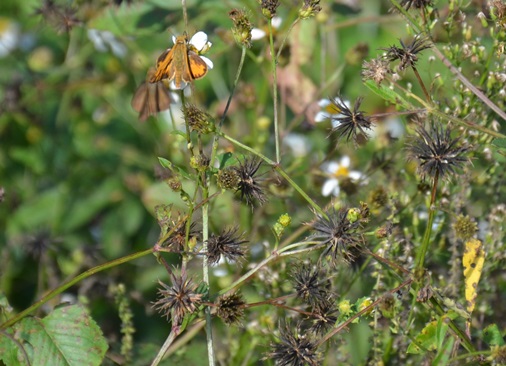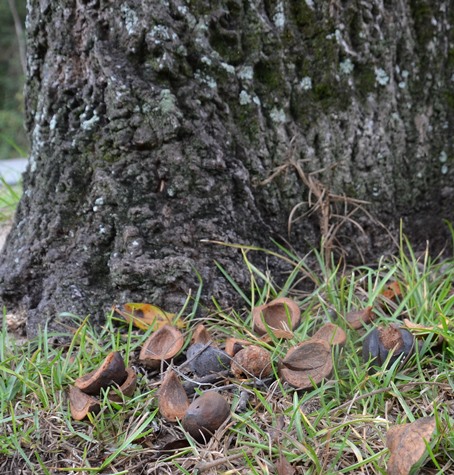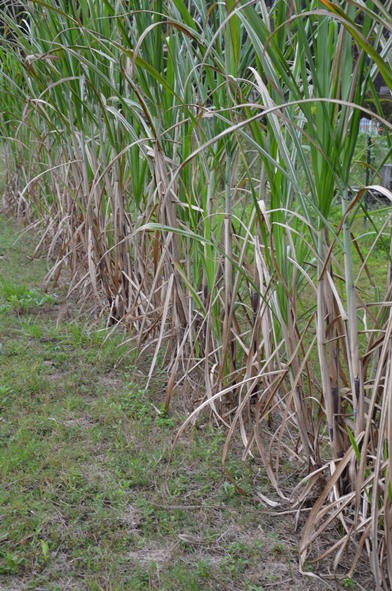by Les Harrison | Dec 2, 2013

Bidens alba is locally know as Spanish Needles because of its stiff prickly structure. It will hitchhike to a new location on anything it contacts.
Hitchhiking was once a common means of low cost transportation. A person would walk to the nearest road and hold out their left fist with the thumb pointed up while attempting to make eye contact with drivers.
In a simpler time hitchhikers were commonly provided a ride to a predetermined spot on the map. In exchange they provided companionship and conversation to the driver.
Change in travel preferences notwithstanding, north Florida still has plenty of active hitchhikers which are seeking a cheap means of travel. The autumn environment stimulates plants with hitchhiking seeds to relocate to new territory open for colonization.
One of the most common hitchhiking seeds locally is Bidens alba. It is known by an assortment of common names including Spanish needles, Beggar’s-tick and Hairy Beggar’s-tick and is a member of the daisy family.
The genus name Bidens means two-toothed and refers to the two projections found at the top of the seed. The species name alba means white which refers to the flowers with white pedals and a yellow center.
This Florida native annual uses the two hooked prongs at the end of the seed to attach itself to anything coming into contact. Each plant produces an average of 1,205 seeds which germinate in the spring.
This weed is common in disturbed areas such as roadside ditches and fence rows with full sun exposure. It is capable of growing to six feet in height, but will take mowing and continue blooming.
The relatively recent interest in wildflowers has encouraged the propagation of this plant for landscaping purposes. Additionally, it is a popular late-season source of pollen for honeybees and other pollinators.
Hackelia virginiana is another hitchhiker currently active in the panhandle. Common names for this weed include Beggar’s Lice, Sticktight and Stickseed and mothers countywide have removed these from their children’s clothing.
The seed pods are approximately 1/8 inch long and are covered with stiff bristly hairs protruding in every direction. Like Spanish needles, anything which brushes against these seeds will carry at least a few to new locations.
The seed pods are green, but will dry to a dark brown. When the outer husk is peeled away, the seed appears as a tiny tan to white bean.
The plant is an erect and has a single stalk about three feet in height. This shallow-rooted plant produces a bloom in mid-to-late summer and seeds in October.
This biennial plant has yet to gain the appreciation of wildflower lovers. It is still considered a weed pest and treated as such.
One byproduct of hitchhiking weeds has been the invention of Velcro. One half of this product resembles coarse fabric and the other side mimics the texture of a cocklebur, a hitchhiking agronomic weed pest.
To learn more about the hitchhiking seeds, visit your local Extension office in person or on the web.
by Les Harrison | Oct 25, 2013

Hickory nuts are popular with squirrels in the autumn.
There is a lot to be gained from having a tough reputation. Only those with a stout disposition or lack of good sense will dare to make a challenge to the individual who hold this distinction.
Unbending, rigid and durable are descriptors which invoke a firm, if not dogmatic, state of resiliency. With this enviable identity, many compare themselves and some assimilate the traits they most admire.
Andrew Jackson is a good case in point. The seventh president grew up on the frontier, dueled with enemies, and commanded an army during the War of 1812 where he was given the nickname Old Hickory.
Like Jackson, hickories are native to North America and are highly valued for their long wearing qualities. While this president no longer visits north Florida, there are plenty of hickories growing in home landscapes.
There are three hickories in panhandle Florida, bitternut, mockernut and water. The water hickory is usually found in wetter areas and the other two species in upland sites.
This genus, Carya, is found in North America and East Asia. The term identifying this genus was coined in Greek mythology and originally referred to a woman who was transformed to a walnut tree.
Karya, or so the story goes, was the daughter of a divinely well-connected king who had gained favor with Apollo. As a courtesy, Karya and her sisters were granted the skill of prophecy from the deity.
As is typical of Greek myths and soap operas, the sisters misused their gift of divination and were punished. Karya was turned into a walnut tree by her boyfriend who was the mythological god of winemaking and ritual madness.
Legendary tragedies aside, hickory trees have a wide variety of contemporary uses commercially and environmentally.
The wood of hickories is relatively hard and is used where a durable and sturdy material are required. Tool handles and flooring are two of the most common uses today.
Prior to the development of modern composite materials, hickory lumber was utilized in vehicle parts, golf club shafts, archery equipment, and a variety of other uses which anticipated hard use. Hickory was originally used to construct baseball bats until ash gained popularity because of its lighter weight.
Hickories are an excellent specimen tree in a landscape. These tall, deciduous trees usually grow from a single trunk and provide excellent shade during the summer.
The leaves can deliver a bright yellow show in the autumn and, if planted on the south side of a home, provide passive solar heating during the cooler months. Mockernut and water hickory nuts have been used in recipes, but are difficult to crack.
One caution is not to establish a hickory near a home or other structure. Squirrels will quickly identify the nuts as a food source and can be quite messy.
Another problem issue is if a tree falls during a storm. The logs are quite heavy and will likely crush anything they hit, especially homes and vehicles.
Hickory is popular and long burning firewood. It is also widely used by bar-b-q devotees who prize the distinct flavor it imparts.
To learn more about hickory trees in north Florida , visit the nearest UF/IFAS County Extension Office or read this infromative publication on the water hickory.

by Les Harrison | Oct 21, 2013

Row of sugar cane. Image Credit: Les Harrison
By Les Harrison, UF/IFAS Wakulla County Extension Director
October has ushered in the fall gardening season. Turnips, mustard, radishes, carrots and a variety of other cool season crops have emerged and are growing.
Another once common crop ready to be planted in October is sugar cane. Cane for processing is harvested, and select stalks with the most desirable traits are planted in October and November.
Planting is accomplished by digging a shallow furrow and laying the canes end-to-end. The cane is then covered with the soil removed from the furrows. Sugar cane may also be planted in north Florida during March.
In the days before mass market sweeteners, almost every farm had a patch of sugar cane. Some varieties were planted for processing into cane syrup, molasses and raw sugar, and some for chewing by the young and those with a sweet tooth.
When not pulling a plow or wagon, mules spent their days walking in a circle to drive a cane mill. Enterprising growers frequently sold their excess production as a means of generating another revenue stream to support the family farm.
Roadside sales of homemade cane syrup were a common sight in the rural south for many years. Sampling was a quality assurance courtesy offered to the potential buyer confirming the syrup had not been scorched while cooking.
The sugar cane plant is a form of grass with high sucrose content. It originated in south Asia where it has been cultivated for several millennia.
Over the centuries, sugar cane production followed the trade routes west. Christopher Columbus brought it to the New World on his second voyage west.
South Florida has long had a large commercial cane sugar industry with thousands of acres committed to growing and processing the sweetener on the outskirts of the Everglades. Louisiana is the other big sugar cane state, but Brazil is the global production champion.
The perennial nature of sugar cane allows growers to harvest the cane, and then grow the following years’ crop off the existing roots. Ratooning, as it is termed, is a widely used practice which has application for growing in panhandle Florida.
From a nutritional standpoint, sugar cane based products are a source of carbohydrates in the diet. Generally speaking, the reason for addition of sugar to a recipe is an issue of taste and flavor.
The sugar cane currently growing in the UF/IFAS Wakulla County demonstration garden was planted in November 2012. Tours of the garden are available during normal business hours.
To learn more about growing sugar cane in Wakulla County, visit the UF/IFAS Wakulla County website or call 850-926-3931 . And “Like” us on Facebook.
. And “Like” us on Facebook.




